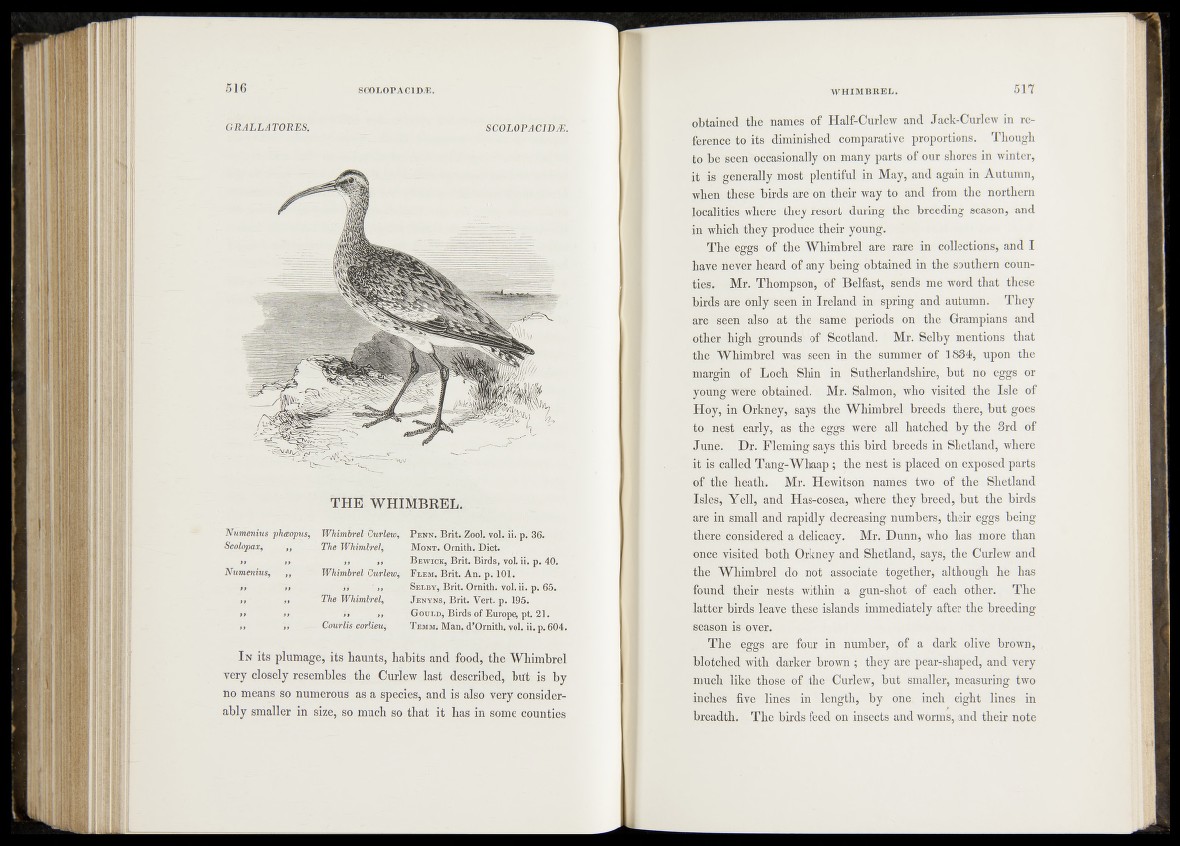
GRALLATORES. SC0L0PACW2E.
T H E W H IM B R E L .
Mumnius phmopus,
Scolopax, y /
Numenius, ,,
Whimbrel-Gürlew,
The Whimbrelj
Whimbrel öttrlew?
The Whimbrel,
Courlis corlieu, ~
P enn. jMtyZoo]. yoly ii. p . 36.
Mont.. Ornith. Diet.
B ewick, Brit. Birds, vol. ii; p. 40.
Flem. Bftt. ^ n . p. 101.
Selby* Brit. Ornith.- vol. ii. p; 65.
JjENYNs, Brit. Vert. p. 195.
trouLD, Birds of Europe,-pt.' 21.
-Temm; Man, d’Ornith; vol.ii. p. 604.
I n its plumage; its haunts, habits and food, the Whimbrel
very closely resembles the Curlew last described* but is by
no means so numerous as a species* and i$ also very considerably
smaller in size, so much so that it has in some counties
obtained the names of Half-Curlew and Jack-Curlew in reference
to its diminished comparative proportions. Though
to be 'seen occasionally on many parts of our shores in winter,
it -is generally most plentiful in May, and again in Autumn,
when these birds are on their way to and from the northern
localities where they resort during the breeding season, and
in which they iprodiïée; their young.
The eggs of'the Whimbrel are rare in collections, and I
.haVeneyer heard of any being obtained in the southern counties.
Mr. 'Thompson* of Belfast, sends me word that these
birds are onlyfsdèn.in Ireland an spring and autumn. They
are seen also at tjie same, periods on the Grampians and
other high grounds' of' Scotland. Mr. Selby mentions that
the Whimbrèl was --Seen in the summer of 1834, upon the
margin of Loch Shin • in LSjtherlandshire, but no eggs or
^o|ja% Were obtained. Mr. Salmon, who visited the Isle of
Hoy, -inf Orkney,- says the Whimbrel brëëds there, but goes
tonnest early, as the eggs wéte« all hatched by the 3rd of
J u n |t Dr. Fleming says this bird breeds in Shetland, where
it i§\eM|ed Tang-Whaap; the nest is placed on exposed parts
of üthe heathi Mr. Hewitsdn names!, two of the Shetland
Isles,"Yell* and Has-cosea, where they breed, but the birds
are in small and rapidly decreasing numbers, their eggs being
there considered a delicacy. Mr. Dunn, who has more than
ongfeyisited both Orkney and Shetland, says, the Curlew and
the Whimbrel; -doj not associate together, although he has
found their nests within a gun-shot of each other. The
latter birds leave; these islands immediately after the breeding
season is over.
The eggs are four in number, of a dark olive brown,
blotched with darker brown ; they are pear-shaped, and very
much like those of the Curlew, but smaller, measuring two
inches five lines in length, by one. inch eight lines in
breadth. The birds feed on insects and worms, and their note